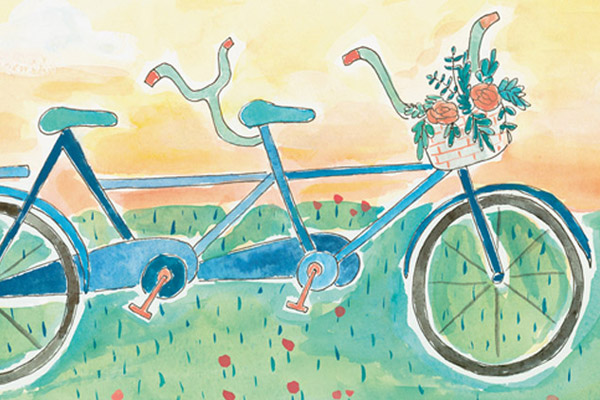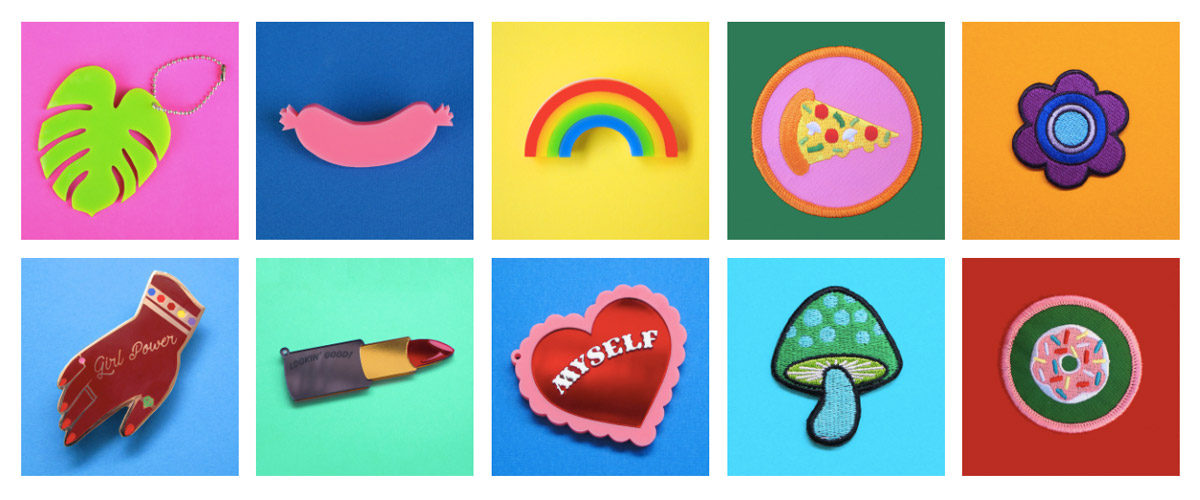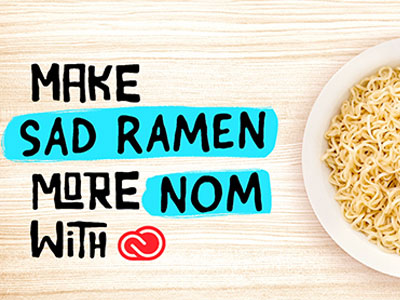From her light-filled studio in a hip Melbourne suburb, an Australian alchemist makes magic out of everyday materials. It’s a place where felt transforms into intricate poster art; paper grows into bouquets of flowers; and skeins of yarn morph into festive drink stirrers. Welcome to the hands-on, polychromatic, cheerfully cluttered world of Kitiya Palaskas.
Palaskas revels in “more is more” excess. Her aesthetic is bright and kitschy, willfully retro but also super fresh. Check out her site for eye-catching, off-kilter client projects, which include everything from a plush puppet mascot for British band The Wombats, to partyware plates, cups, and more for the We Love Sundays boutique. Pop by her Instagram feed for quick, colorful glimpses into her latest goings-ons, which often include glitter, good friends, or a cocktail. (Sometimes all at once.) It’s easy to be enchanted with her wares, and Palaskas is clearly busy living her best life; but what, exactly, does that entail?
Kitiya in her studio (left) and her props on set (right)
“I’m quite niche,” she says with a laugh. “And I’ve found it can be hard to explain myself in a way that’s not too obscure, that other people can understand. I had been calling myself a ‘craft-based designer,’ but that doesn’t mean anything to anyone because it’s just a term that I made up.” Instead, she’s going with “stylist and prop designer.” And then some! “I create objects, images, sets, and installations. I write DIYs, I teach workshops, I mentor others. I do client-based work. The thing that ties them together is that they all have a base in craft, with things that I’ve handmade.”
In many ways, Palaskas represents an archetype of the modern maker: a web-savvy, multi-talented go-getter who has blazed a non-traditional professional trail, dabbling in—then later foregoing—standard 9-to-5s for a freelance career (albeit one that defies simple description). She’s built a business around her varied work and around herself; Kitiya Palaskas is both a thriving person and a thriving brand. The two are intrinsically linked; as one develops, so does the other.
The balance is largely natural, as Palaskas crafts like fishes swim. “I think it’s always been in my genes,” she says of the knack. “My mom is an avid crafter—like, absolutely prolific, doing everything under the sun—and my dad is a graphic designer turned academic. He’s also an incredible photographer, which gave him a more technical approach.” This supportive start was enough to get Palaskas going, guiding her through a childhood where she remembers constantly collecting trinkets and making others, and on to her teenage punk phase, when she was drawn in by the scrappy practices of hosting gigs, screen-printing t-shirts, photocopying zines, and cobbling together merch. “That was something I was really inspired by, and I took that DIY ethos to heart. I’ll teach myself how to do things, and train myself based on what I want to pursue.”
Kitiya's paper craft styling (left) and her patches and products (right)
Palaskas studied printmaking at university, but she found the practice limiting in a way that made it difficult to imagine following full-time after graduation. “It was too technical—you have to register everything!—and I’m actually shit at technical stuff. The making process for me is a lot more organic. Plus, art school will teach you skills but give you no idea how to monetize them.” And thus began a journey that has seen Palaskas gaining practical experience across a range of fields. “I’ve had my own fashion label, I’ve done fashion styling, I’ve done interior styling, I’ve worked for Better Homes & Gardens. I’ve done all these random things and always kept pivoting.” The variety was a great way to stay active and engaged, but difficult for her to make sense of with relation to a bigger picture. “For a long time I felt that I couldn’t stick with one thing because I lacked motivation, or was lazy—something negative. Then I saw Emelie Wapnick’s TED Talk about multipotentialites—people who constantly desire to diversify, never satisfied on one path—and I was like, ‘Oh my god, that’s me!’”
Identifying this side of herself helped Palaskas turn what felt at times like a liability into something central to her being, and therefore her brand and business. “Now I can shift around and still have my work feel cohesive,” she says. But coming into her own hasn’t been without its hardships, and turning happy hobbies into a sustainable career isn’t always easy.
“I’m going to be super honest: I have learned a lot by making really embarrassing mistakes,” she says. “Some of them have been client-facing, some behind the scenes. But I’ve always felt if I’m on the cusp of something, I’m not going to hold back because, say, I don’t know how to write an invoice. I’ve Googled so many things about how to be a businessperson.”
Kitiya's felt artwork for musician and actress Lily Allen (left) and her yarn drink stirrers (right)
Being honest about the ups and downs of navigating all aspects of creative living—especially the logistical side—is something Palaskas feels strongly about. “I talk openly about it because I have a responsibility to share my story,” she says. “I don’t want to sugarcoat it or make people think it was all luck. This is the first year, after seven years of doing what I do, that I’ve really taken control and feel like, ‘I’ve got this now.’ I’m not floundering around. But I also know that I’ve got so much more to learn.”
This includes lessons on how to keep the flame alive for crafting, which has developed complex implications between the public and private divide. “I’m so wrapped up in it,” she says. “I’m counting on a small portion of my success in the industry to how my personality comes across, because I’ve made it to be that way. But that makes it difficult to get what feels like a proper perspective on my work. On the upside, it’s incredibly empowering to be one-hundred-percent in control of how I want to do things. It’s second nature because it’s coming directly from who I am.”
For the most part, Palaskas is okay with the blurred professional lines of her projects, but she understands that not everything has to be posted for likes and feedback. “When something you love becomes your job, it’s really important to take steps to make sure you don’t burn out,” she says. “I’d hate to lose my passion.” To protect the enjoyment and sanctity of what is now her livelihood, Palakas keeps some simple pleasures under wraps.
“This is where personal projects come in handy,” she says. “There are some things I’ve picked up that I discovered and just haven’t told anyone about. I love aromatherapy, and I’ve gotten really into mixing up different essential oils in the studio to suit how I’m feeling that day—but I’m not trying to sell them as products. At the moment I’m also super into indoor plants; I’ve had a great time nerding out on all my little plant babies, which have been a good outlet for me. I’ve started experimenting with ceramics; it’s so liberating to be at the start of some new crafty thing.”
Another key element that helps Palaskas stay on track is keeping her studio in order. She shares her space with artist and old friend Spencer Harrison, and the building—a still-operational zipper factory—houses a hive of other creative types. After meditating at home and completing her daily Artist’s Way morning pages, Palaskas bikes the seven minutes from home to the studio. And while it may appear haphazard, she has established a just-so environment for maximum creative efficiency.
More examples of Kitiya’s boundless creativity. Photo credits left to right: Paper Stone Scissors, Alfie's Childrens Apparel, and Hail and Shine.
“I need to feel cozy and comfortable to be able to work,” she says. “It really makes a difference when I’m in an aesthetically pleasing space.” For Palaskas, that means having the tools of her trade convenient at all times. Glue guns, hammers, and acrylic sheets share cupboard and shelf space with colored string, rulers, and an array of scissors, like an elementary school classroom grown up. “I like everything to have a place—even if that place is on the ground—so I know where I can find it.”
On her desk, Palaskas keeps supplies she needs regularly (double-sided tape, stationery, markers, pencils, sketchbook, etc.). The rest of the available surfaces, both horizontal and vertical, are almost completely covered with things that inspire her. “I’ve always been a collector; snow globes when I was a kid, swizzle sticks now,” she says. “So that curatorial thing has always been in me. Some people can have a Pinterest board they turn towards for inspiration—and I do have that, too!—but I need to be sitting in a place that’s surrounded by interesting, stimulating things to look at.”
Making physical things with meatspace materials doesn’t have to be mutually exclusive with developing keen technology know-how. Adobe apps are an integral part of her process. “Obviously Photoshop is great for editing images, and InDesign is so helpful for marketing materials and workshop layouts,” Palaskas says. “Illustrator, though, has really surprised me. I used to shy away from it because it was so daunting, but it’s mind-blowingly helpful.”
Of course, she uses it in a typically unconventional way. “I’m terrible at drawing. I can freehand-cut any shape in the world out of paper, but I wouldn’t feel comfortable doing the same thing with a pencil,” she says. “So if I want to create, say, an image of a pizza slice, I’ll cut it out from black paper, scan it in, then manipulate and turn it into a vector in Illustrator. From there I can create an image or a file to go straight to the laser cutter.”
She used this process to complete all the concepts and templates for her upcoming book, Piñata Party: 30 Craft Projects for the Ultimate Party Accessory, which offers how-tos for the festive cardboard constructions as well as a whole host of “piñata accompaniments” (think backdrops, earrings, and other goodies). Folks in Australia can nab a copy when it comes out in October, but partygoers elsewhere will have to hang tight until it’s released in April of 2018. In the world of Kitiya Palaskas, there’s always something fun to look forward to.
June 29, 2017





.jpg)

